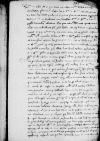Accepi hic a Dominatione Vestra Reverendissima ⌊⌋, ⌊⌋, quibus mihi pro paterno suo in me amore et propensione declarat me in coadiutorem cum successione Dominationis Vestrae Reverendissimae a ⌊venerabili capitulo Varmiensi⌋ electum[1]. Pro quo actu Deo meo, quas mortalis mea imbecillitas potest, gratias habui, ab eius divina misericordia rogans, ut, quae ad utriusque animarum nostrarum salutem pertinent, misericorditer nobis concedat. Habeo et Dominationi Vestrae Reverendissimae gratias immensas, quod usque ad eum finem negotium hoc promoverit. Sicque me in omnibus erga Dominationem Vestram Reverendissimam geram, quod numquam paenitere poterit hoc in me beneficium contulisse. De articulis iurandis[2], cum Deo duce ⌊domum⌋ rediero, quemadmodum Dominatio Vestra Reverendissima consulit et praescribet, faciam omnia. Quod Dominatio Vestra Reverendissima de ⌊domino praeposito⌋ scribit, nondum intellexi quippiam illum petere de reservatione aut pensione, peteret enim frustra. Verum coniunxit se ⌊nuntiis nobilitatis⌋[3], opera quorum sperat episcopari, multaque contra ecclesiam Dominationis Vestrae Reverendissimae et meam cum ⌊Kiiewszki⌋, qui nuntiorum secretarius est, spinosamque hanc rhetoricam contra nos confecit, quam a domino ⌊Ioanne a Werden⌋[4] Dominatio Vestra Reverendissima accipiet, tractavit, neque adhuc tractare desinit. Existimo, quod iuramentum ecclesiae praestitum in se longe aliud contineat etc.
⌊Serenissima maiestas regia⌋ iussit in consilio, nobis ad id vocatis, libellum[5] mere famosum ⌊nuntiorum nobilitatis⌋ legi. Cuius nobis petivimus dari exemplum, non ob id, quod eis responderemus, quandoquidem nobis aliud in novissimo ⌊Elbingensi conventu⌋[6] promiserant, utpote se nihil contra nos conquesturos, sed ut per modum consilii ⌊serenissimam maiestatem regiam⌋, quomodo omnia in veritate habeant, edoceremus.[7] Iamque illa scribi iussimus. Ceterum nescimus, si ad praesens cum hoc nuntio mitti possint; si nunc non erit commoditas, erit paulopost. Post lectionem libelli iniunxit ⌊serenissima maiestas regia⌋ ipsis ⌊nuntiis⌋, ut nobiscum postero die in meo hospitio convenirent, si forte ad aliquam inter nos compositionem res duci posset. 1537-01-21⌊Pridie1537-01-21⌋ igitur, cum in negotiis ⌊illustrissimi domini comitis palatini Ottonis Henrici⌋ ad me descriptis ad ⌊serenissimam maiestatem regiam⌋ me conferrem, quaesivit a me ultro ⌊maiestas regia⌋ vulgari Germanico, an cum ⌊nuntiis⌋ convenissemus et ad concordiam aliquid egissemus. Respondi nos quidem convenisse, verum de concordia nihil
 BCz, 242, p. 186
actum, neque hic agi posse, cum ⌊nuntii⌋ veri libelli contra nos articulos proposuissent praescribentes ⌊maiestati eius⌋, quae per illam fieri velint,
ms 2 3 4 totum,
BCz, 242, p. 186
actum, neque hic agi posse, cum ⌊nuntii⌋ veri libelli contra nos articulos proposuissent praescribentes ⌊maiestati eius⌋, quae per illam fieri velint,
ms 2 3 4 totum,
ms 1 totu[m] paper damaged⌈totumms 2 3 4 totum,
ms 1 totu[m] paper damaged⌉ ⌊consilii nostri⌋ ordinem, quasdam etiam seorsum personas acriter ms 2 3 4 pungentes,
ms 1 pungente[s] paper damaged⌈pungentesms 2 3 4 pungentes,
ms 1 pungente[s] paper damaged⌉, ne scilicet ⌊maiestas eius⌋ cuiquam castra aut oppida tenenda vel dignitates, maxime ecclesiasticas, conferret, quam qui nobilis esset eisque placeret. Ad ms 2 3 4 ea,
ms 1 [ea] paper damaged⌈eams 2 3 4 ea,
ms 1 [ea] paper damaged⌉ ⌊maiestas regia⌋ Germanice inquit: das ist nicht yr ding, es virt ms 2 n(i)chts,
ms 1 n(i)ch[ts]⌈n(i)chtsms 2 n(i)chts,
ms 1 n(i)ch[ts]⌉ doraus[8], cum quodam haec dicens in illos stomacho, unde bona nos spes habet, quod eorum conatus, quantumvis ⌊reginalem maiestatem⌋ ⌊palatinumque Cracoviensem⌋ adiutores habeant, non omnimode succedent. 1537-01-22⌊Hodie1537-01-22⌋ iterum mane ad hospitium meum sunt venturi, quumque ⌊maiestas regia⌋ ms 2 3 4 negotium,
ms 1 negoti[um] paper damaged⌈negotiumms 2 3 4 negotium,
ms 1 negoti[um] paper damaged⌉ parvarum civitatum cum illis tractandum nobis commiserit, dabimus operam, si aliquam inter nos compositionem facere possemus etc.
Quando ⌊maiestas regia ms 2 3 4 iunior,
ms 1 iuni[or] paper damaged⌈iuniorms 2 3 4 iunior,
ms 1 iuni[or] paper damaged⌉⌋ iurare debebit, nondum satis certum est[9]. Quidam etiam dubitant; ista nos hic tenet expectatio cum meo magno incommodo et detrimento. Iam siquidem octingentas marcas nostras absumpsi nesciens adhuc, quo tempore hinc absolvar. Domino Deo me commisi,
cf. Vulg. Hbr 11. 40 Deo pro nobis melius aliquid providente, ut non sine nobis consummarentur. ⌊Ille sua immensa misericordia mihi providebitcf. Vulg. Hbr 11. 40 Deo pro nobis melius aliquid providente, ut non sine nobis consummarentur. ⌋. Eius divinam precor Maiestatem, ut Dominationem Vestram
Reverendissimam quam diutissime pro singulari mea consolatione incolumem et felicem conservet, cuius paterno amori me summopere commendo, rogoque has extemporarias boni consulere dignetur, paulopost per proprium nuntium de omnibus diffusius scripturus.
 BCz, 242, p. 186
actum, neque hic agi posse, cum
BCz, 242, p. 186
actum, neque hic agi posse, cum 
